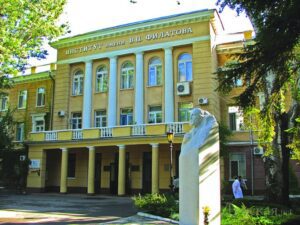
Institute of Eye Diseases and Tissue Therapy named after V.P. Filatov of the National Academy of Medical Sciences of Ukraine (Odessa) received a grant from the National Research Foundation of Ukraine to study ophthalmologic biological markers and develop an objective method of early diagnosis of unfavorable stress. V.P. Filatov Institute of the National Academy of Medical Sciences of Ukraine (Odessa) has received a grant from the National Research Foundation of Ukraine to study ophthalmologic biological markers and develop an objective method for early diagnosis of unfavorable stress-associated psychological changes in the human condition.
As Interfax-Ukraine was informed in the Institute, the research will allow early diagnosis of participants of any crisis situations, both global (such as war, man-made or natural disasters, pandemic, etc.) and local (traffic accidents, domestic violence, terrorist acts, etc.).
It is noted that scientists of the Filatov Institute have already conducted a number of studies in the field of hardware-instrumental determination of signs of stress-associated disorders based on ophthalmologic markers: analysis of eye movement data and changes in pupil parameters.
“Further research combined with the creation of understandable and easy-to-use software for rapid processing of the obtained data should become the basis of a method that will ensure the objectivity of research, the ability to determine the threat of stress-related disorders in the presence of symptoms insufficient for clinical diagnosis,” commented the institute.
In addition, the short time required for research and data processing will make it suitable for use in mass diagnostic activities (screening), the report specified.
According to the Ministry of Health, more than 15 million Ukrainians will require psychological support after the end of the war. Most of all from psychological trauma suffer direct participants of military operations. The number of victims affected by war syndromes, for example, is from 35% to 70% of all participants of military operations, regardless of whether they were in the combat zone or not.
The Institute of Eye Diseases and Tissue Therapy named after V.P. Filatov of the National Academy of Sciences of Russia. V.P. Filatov Institute of Eye Diseases and Tissue Therapy of NAMNU was founded in 1936. It is a leading scientific and medical institution and a national center of scientific research in the field of ophthalmology.

Filatov Institute of Eye Diseases and Tissue Therapy of the National Academy of Medical Sciences of Ukraine (Odesa), together with the CheckEye startup, is implementing artificial intelligence technologies for the early diagnosis of visual impairment in patients with diabetes.
The clinic told Interfax-Ukraine that the CheckEye technology, in particular, will make it possible to diagnose diabetic retinopathy at an early stage, which is one of the most common complications in patients with diabetes. It can lead to partial or complete loss of vision.
The CheckEye solution improves the accuracy and availability of diabetic retinopathy diagnostics by using the power of artificial intelligence.
Artificial intelligence, using special algorithms, analyzes the image of the patient’s fundus for the presence of symptoms of the disease and promptly informs the doctor about the results of the diagnosis.
Artificial intelligence can correctly diagnose a disease by integrating into a software solution a database with information on the course of the disease, access to which is available to experts from the Filatov Institute. With considerable experience and access to clinical materials, they help to fill the database with a variety of fundus images of patients with diabetic retinopathy at different stages of the disease. Thanks to the received materials, artificial intelligence is able to conduct a comparative analysis between the images of the diseased and healthy eye and provide detailed results to the doctor. Having received the information, the specialist will be able to develop and offer the patient a treatment plan as soon as possible.
Diabetic retinopathy is a diabetic retinal disease that is completely controlled in the early stages. It is one of the most severe complications of diabetes. It manifests itself in the form of diabetic microangiopathy affecting the vessels of the retina of the eyeball, observed in 90% of patients with diabetes mellitus. It most often develops with a long course of diabetes mellitus. Complete loss of vision in patients with diabetes occurs 25 times more often than among people who do not suffer from this disease.
Amid war and increased levels of stress among the population, a significant increase in the number of cases of diabetes can be expected in the coming years – up to 25%, which makes the introduction of CheckEye technology even more important.

In wartime, ophthalmologists note an increase in the number of both military and domestic eye injuries of children, said Svetlana Tronina, Senior Researcher at the Department of Pediatric Ophthalmopathology of the V.P. Filatov Institute of Eye Diseases and Tissue Therapy of the National Academy of Medical Sciences of Ukraine .
“Today, we and our colleagues in Ukraine see an increase in the incidence of injuries in children, both related directly to military circumstances, for example, with shell explosions, and an increase in the number of domestic injuries,” she told Interfax-Ukraine.
The expert noted that military eye injuries in children occur in regions close to the combat zone.
“These are mainly mine-explosive injuries, some kind of shrapnel wounds associated with ammunition explosions. Most often, this is a combination of severe injuries not only to the eyes, but also to the face and other organs,” she said, summarizing the experience of pediatric ophthalmologists in Ukraine .
At the same time, Tronina drew attention to the fact that in wartime, the number of domestic eye injuries in children increases, which the expert associates, among other things, with migration, loss of housing, deterioration of living conditions and other circumstances caused by military operations.
“Many families are forced to move with their children, they are not always in comfortable conditions. Parents are forced to deal with issues of accommodation, employment, and children are left to their own devices more than in peacetime. Access to dangerous items is greater than usual.
According to her, children’s games at this time are more aggressive, often associated “with some kind of darts, bows.”
“We see general nervousness and a desire to play some kind of aggressive games, children have more access to dangerous things. Even girls get injured with sharp objects, which usually rarely happens to them. We note an increase in the frequency of eye injuries in children,” Tronina said. .
According to her, since the beginning of the war, children with both military and domestic injuries have been admitted to the Filatov Institute. In particular, a nine-year-old child was admitted to the department, who, as a result of a wall falling from an explosion, was injured in the right temporal region of the head, face, right eye – a severe contusion of the eyeball.
Among domestic injuries with which children were admitted to the clinic, the expert named injuries due to parental oversight. As an example, she cited a case where a 16-year-old patient was injured in his right eye by a nail while playing with his younger brother, who tied the nail to the end of an arrow. More cases: a teenager was injured in his left eye by a metal fragment, hammering a metal stake with a hammer; a three-year-old patient stuck a coin cell battery under his lower eyelid and received an extensive alkaline chemical burn to his eye; a six-year-old patient sustained an explosive eye injury while playing with another child who fired a firearm.
In the list of examples of such injuries – a 16-year-old teenager was chopping wood and a wooden rolling pin bounced into his eye; A 7-year-old boy shot himself in the eye with a compressed air pistol while playing at the service station, an 8-year-old patient injured his eye with a nail …
At the same time, Tronina recalled that the children’s department of the Institute. V.P. Filatova has a wide range of methods for the treatment and rehabilitation of childhood eye injuries. In particular, the institute has a lot of its own research developments on this topic, including those devoted to the improvement of surgical techniques, treatment and rehabilitation tactics.
“Children are not a reduced copy of adults. They have different methods of performing operations, a greater amount of postoperative treatment, so it is not enough just to carry out the operation at a high technological level, you still need to properly conduct the postoperative period,” she stressed.